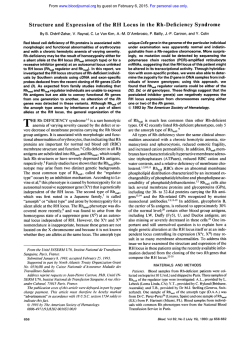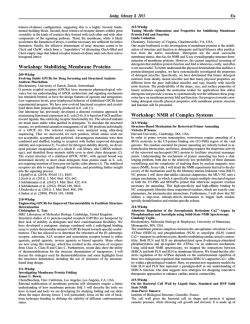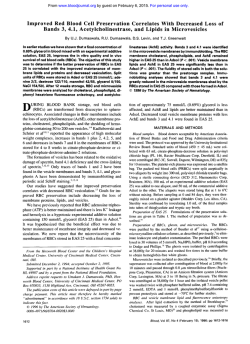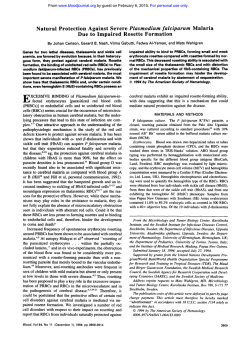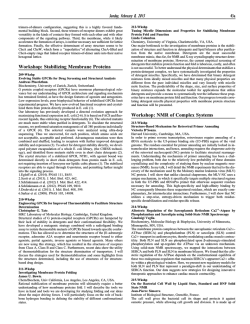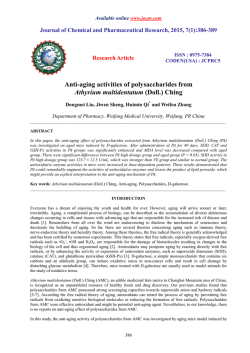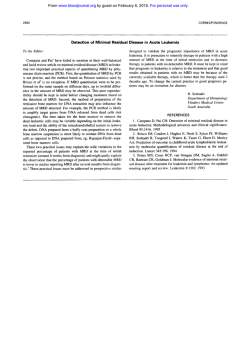
Rheologic Properties of Senescent Erythrocytes: Loss of
From www.bloodjournal.org by guest on February 6, 2015. For personal use only. Rheologic Properties of Senescent Erythrocytes: Loss of Surface Area and Volume With Red Blood Cell Age By Richard E. Waugh, Mohandas Narla, Carl W. Jackson, Thomas J. Mueller, Takashige Suzuki, and George L. Dale The rheologic properties of senescent erythrocytes have been examined using two models of red blood cell (RBC) aging. In the rabbit, aged erythrocytes were isolated after biotinylation, in vivo aging, and subsequent recovery on an avidin support. Aged RBCs from the mouse were obtained using the Ganzoni hypertransfusion model that suppresses erythropoiesis for prolonged periods of time allowing preexisting cells t o age in vivo. In both cases, the aged erythrocytes were found by ektacytometry t o have decreased deformability due t o diminished surface area and cellular dehydration. The aged rabbit erythrocytes were further characterized by micropipette methods that documented an average surface area decrease of 10.5% and a volume decrease of 8.4% for the cells that were 50 days old. because both the surface area and volume decreased with cell age, there was little change in surface-to-volume ratio (sphericity) during aging. The aged cells were found t o have normal membrane elasticity. In addition, human RBCs were fractionated over Stractan density gradients and the most dense cells were found t o have rheologic properties similar t o those reported for the aged RBCs from rabbits and mice, although the absolute magnitude of the bhanges in surface area and volume were considerably greater for the human cells. Thus, stringent density fractionation protocols that result in isolation of the most dense 1%of cells can produce a population of human cells with rheologic properties similar t o senescent cells obtained in other species. The data indicate that progressive loss of cell area and cell dehydration are characteristic features of cell aging. o 1992b y The American Society of Hematology. T their physical properties, specifically their in vitro deformability, membrane elasticity, and the ratio of surface area to volume. HE MAMMALIAN erythrocyte must survive a variety of chemical and physical insults during its lifespan. The potential chemical challenges include, among others, oxidant stress, metabolic depletion, and loss of ion gradients,' all of which the cell resists via an impressive repertoire of enzymatic mechanisms. The physical challenges to the erythrocyte are framed by the need for the cell to deform from its resting diameter of approximately 8 pm to diameters as small as 1.5 pm as it traverses capillary beds and splenic sinusoids. The erythrocyte is remarkable in its physico-elastic properties. The red blood cell (RBC) membrane maintains structural integrity while subjected to large stresses and deformatiofis, yet remains highly deformable with an elastic modulus softer than the softest latex rubber.' However, there has been considerable d i s c ~ s s i o n as ~ . ~to how well the cell's rheologic properties survive a lifespan that involves approximately 1.7 X 105 complete cycles through the vascular circulation' over a period of 30 to 200 days, depending on the species.' Are there progressive changes in cellular properties over the life of the cell that might cause or contribute to the eventual removal of the cell from the circulation? Several precedents for this scenario of decreased deformability affecting the cell's lifespan are provided by a variety of hemolytic anemias. For example, the RBCs from patients with hereditary spherocytosis, hemoglobin CC disease, sickle cell anemia, and autoimmune-mediated spherocytosis have all been documented to have decreased deformability in association with decreased RBC life~pan.~~'"" A major hindrance to the examination of erythrocyte senescence has been the difficulty of isolating aged cells.'.'z The vast majority of studies in the field of RBC aging have used density fractionation to produce a population of dense cells that has been assumed to be aged erythrocytes. Recent work has shown that this conclusion is not acc~rate,'~.'~ and, as a result, much of the work in the literature concerning aged RBCs is of questionable value. Several techniques for the unambiguous isolation of aged RBCs have been develped.'^,'^-^ In this report, we have used two of these methods to isolate senescent RBCs from rabbits and mice. These aged erythrocytes were then examined with regard to Blood, Vol79, No 5 (March 1). 1992: pp 1351-1358 MATERIALS AND METHODS Isolation of Aged Erythrocytes The average lifespan of rabbit and mouse erythrocytes is 60 days? Aged erythrocytes from rabbits were isolated with a recently reported method that involves the biotinylation of erythrocytes with N-hydroxysuccinimido biotin?' Specifically, 2.5 kg rabbits were injected on 3 consecutive days with 7.5 mglkg phenylhydrazine to produce a reticulocytosis; control experiments have shown that 70% to 85% of all preexisting cells are destroyed by this procedure (data not shown). Ten days later, the rabbit RBCs are biotinylated in vitro by reaction with N-hydroxysuccinimido biotin as previously described?' These biotinylated cells have been shown to have a normal in vivo survival?1 After reinfusion, the biotinylated cells are allowed to age in vivo for various periods of time. The animal is then bled again and the biotinylated RBCs are recovered by binding to avidin-coated, plastic Petri dishes as described." The recovered cells are removed from the Petri dishes From the Department of Biophysics, University of Rochester, School of Medicine and Dentistry, Rochester, W;the Division of Cell and Molecular Biology, Lawrence Berkeley Laboratoy, University of California, Berkelq, CA; the Departments of HematologylOncologv and Biochemistry, St Jude Children's Research Hospital, Memphis, TN; and the Department of Molecular and Experimental Medicine, Research Institute of Scripps Clinic, La Jolla, CA. Submitted December 6, 1990; accepted October 24, 1991. Supported in part by Grants No. AG08545, HL18208, DK26263, and HL30489from the National Institutes of Health, National Cancer Institute (CORE)support Grant No. CA 21 765, and by the AmericanLebanese-SyrianAssociated Charities. Address reprint requests to Richard E. Waugh, PhD, Department of Biophysics, University of Rochester, School of Medicine and Dentisty, 601 Elmwood Ave, Rochester, NY14642. The publication costs of this article were defiayed in part by page charge payment. This article must therefore be hereby marked "advertisement" in accordance with 18 U.S.C. section 1734 solely to indicate this fact. 0 1992 by The American Society of Hematolog. 0006-4971I921 7905-0019$3.00/0 1351 From www.bloodjournal.org by guest on February 6, 2015. For personal use only. WAUGH ET AL 1352 by collagenase digestion of the gelatin anchor’’ used to retain the avidin on the plate surface. One advantage of this technique is that when an age-synchronized cohort of cells is initially used for the biotinylation, any desired age of erythrocyte can be obtained, thereby allowing a temporal dissection of the aging process relative to the parameter being examined?’.’’ As mentioned above, the phenylhydrazine treatment does not quantitatively remove existing cells so that the purity of the isolated RBC preparations is not as great for an early isolation (ie, day 8) as it is for the more aged preparations where any cells outside the initial age-window would have been cleared by the natural senescence process. Isolated RBC populations, as well as whole blood samples, were resuspended in autologous plasma at 25% hematocrit and shipped on wet ice via overnight carrier to the laboratories of N.M. and R.E.W. for rheologic measurements. Aged erythrocytes from the mouse were isolated with the Ganzoni hypertransfusion p r o c e d ~ r e . ”With ~ ~ ~ this technique, a large number of starting mice are split into two equal groups, and one group is terminally bled to allow the other group of animals to be hypertransfused. Two weeks later, one half of the surviving animals are terminally bled to hypertransfuse the remaining mice; this procedure is repeated every 2 weeks for approximately 60 days. The model is based on the observation that hypertransfused animals will not synthesize new eythrocytes, and, therefore, the RBC population of the few surviving animals will have a continuously increasing mean age over the 60-day experiment. There are important differences between the biotinylation and hypertransfusion models. When the hypertransfusion procedure has been proceeding for 30 days, the surviving RBCs represent a range of ages from 30 to 60 days old. Only at the end of the hypertransfusion experiment does the age-window of the remaining cells become relatively narrow. In contrast, the age-window in the biotinylation system is determined by the starting population, which is a phenylhydrazine-produced, young cohort of cells. Therefore, the age-window for these cells is approximately 10 days wide and will remain constant during the experiment. However, the use of phenylhydrazine in the biotinylation model must be considered for the potential of introducing artifacts based on the use of this oxidant challenge in the animal. Density Separation of Human RBCs Human RBCs were fractionated using discontinuous eight-step stractan density gradients consisting of 1 mL fractions spanning a density range of 1.084 to 1.120 g/mL in equal increments.= The RBCs from the most dense fraction had a mean cellular hemoglobin concentration (MCHC) greater than 37 g/dL and constituted 0.8% of the total cell population. Ektacytomehy Measurements Deformability of intact RBCs was measured using osmotic gradient ektacytometry, an assay in which whole-cell deformability is measured as a continuous function of suspending medium osmolality? For these measurements, we prepared gradients from two solutions of 4% polyvinyl-pyrilidone (PVP; average molecular weight 360 Kd and viscosity of 22 cp) in phosphate-buffered saline (PBS), one adjusted to 50 mOsm/kg and the other to 900 mOsm/kg. The gradients were mixed in the first stage of the three-stage mixing chamber of a Beckman gradient former (Beckman Instrument Co, Palo Alto, CA). Packed RBCs (70% to 80% hematocrit) were pumped into the second stage of the chamber by a Harvard infusion pump (Model No. 906; Harvard Apparatus, South Natick, MA) and mixed with the gradient to a final hematocrit of 0.2%. Thorough mixing was ensured by passage of the cell suspension through the third stage of the mixing chamber. The suspension was then pumped through a Wescan conductivity meter (Wescan Instruments, Santa Clara, CA) to continuously monitor its conductivity, and finally into the ektacytometer for measurement of cellular deformability, at a constant shear stress of 170 dyne/cm2. The osmolality at which the deformability index (DI) reaches a minimum in the hypotonic region of the gradient has been shown to be the same as the osmolality at which 50% of the cells will hemolyze in a standard osmotic fragility test? This point is thus an index of the average surface area-to-volume ratio of the population of cells studied. Cells attain their maximally deformed state at or near the physiologically relevant osmolality of 290 mOsm. In the presence of normal membrane deformability, this maximum value of DI has previously been shown to be related to the membrane surface area.’ The hypertonic region of the curves provides information on the state of cell hydration. Variations in cell hemoglobin concentration distributions in aging RBC populations was quantitated using the Technicon H-1 hematology analyzer (Technicon Instruments Corporation, Tarrytown, NY).*, Micropipette Measurements The surface areas and volumes of rabbit cells were measured on six different occasions, and four or six samples were tested on each occasion. The samples were grouped according to the age of the labeled cohort: Day,, Day,, (days 22 to 30), and Day,, (days 49 to 51). For each age group there was a cohort sample and a whole blood sample. Day, cells were tested on three occasions, and Day, cells and Day,, cells were tested on four occasions each. In all, over 2,000 cells were measured. The whole blood samples do not necessarily represent a “normal” cell population because the ages of the cells in the blood depend on how soon after phenylhydrazine treatment the blood is obtained. For example, for the Day, sample, the control cells will represent a skewed age population because it is only 18 days after the end of phenylhydrazine treatment of the animal?’ By the time that a Day, sample is drawn for the isolation of biotinylated cells, the animal will be 60 days removed from phenylhydrazine treatment and will represent a more normal distribution of cell ages. As a result, the whole blood samples from Day,, are most representative of normal cells. Details of the micropipette procedures are provided el~ewhere.~, Cells were suspended in PBS (128 mmol/L NaC1,31.2 mmol/L Na phosphate, pH 7.3; 285 to 295 mOsm) plus 3.0 mg/mL bovine serum albumin at low hematocrit ( < 1.0%) and placed in a 1.0-mm thick, U-shaped chamber on the microscope stage. A micropipette (1.0 to 1.5 pm, inside diameter) was inserted into the chamber through the open side of the “U”. To measure the surface area and volume, cells were aspirated at a pressure of 6,000 dyne/cm2(6.0 cm water), a pressure sufficient to form the cell into a sphere plus a cylindrical projection into the pipette. The outside diameter R, and projection length L were measured for each cell, and the surface area (A), volume (V), sphericity (S), and minimum cylindrical diameter (MCD) were calculated according to the following relationships: - + 2%L) - Ri + 3R;L)/3 A = ~ ( 4 R -i R; V = p(4R: S= 4.rrV2’) (4~/3)A ~” .rr(MCD)’ = 3 A . (MCD) - 12V (1) (2) (3) (4) From www.bloodjournal.org by guest on February 6, 2015. For personal use only. PROPERTIES OF SENESCENT RED CELLS 1353 where R, is the inside radius of the pipette. The MCD is the diameter of the smallest tube through which the cell can pass. It was found by numerical solution of equation 4 for given values of A and V using Newton’s method. Some other measures of surface to volume ratio can be calculated from the sphericity: “surface area index” = S-’ and “swelling index” = S-”’. To avoid bias in cell selection, every cell in an arbitrarily chosen field of view was measured. Between 75 and 100 cells were measured for each sample. Occasionally, cells were encountered that could not be used for measurement. These included cells that creased or folded when they were aspirated into the pipette, cells that were too rigid to be deformed into the pipette, or cells that were so small that they were sucked completely into the pipette. The sum of these rejected cells amounted to less than 3% of any sample. Such cells are not included in the statistics. To measure the deformability of the membrane, cells were aspirated near the dimple region at an initial pressure of 200 dyne/cm2. The aspiration pressure was increased in increments, and the length of the projection into the pipette was measured as a function of the pressure. The modulus (k) was calculated according to: p= (Ri/2.45) dP/dL (5) where dP/dL is the inverse of the slope of the length-pressure data pairs. RESULTS Ektacytometry of Erythrocytes Erythrocytes from all three species were examined by ektacytometry to evaluate the deformability changes that may occur during the aging process. The data presented in Figs 1 through 4 address the changes that occur with increasing erythrocyte age in the rabbit and mouse and with increasing cell density in humans. Osmotic gradient deform0.6 0.5 DAY 22 CELL HEMOGLOBIN CONCENTRATION (g/dL) Fig 2. Cell hemoglobin concentration for aged cell cohorts from rabbit. The difference between whole blood samples (left curves) and cohort samples increases progressively with the age of the cohort. The data for the whole blood sample shown in each panel were derived from blood samples of the animal from which the aged cohorts of RBCs were isolated. The variation in these controls represents biologic variation and differences in time since phenylhydrazine treatment. In addition t o the four in vivo aged samples shown here, eight other samples were studied. The 12 samples were obtained from six different animals. The changes in cell hemoglobin concentration documented here are representative of all samples studied. DAY 0 - 0.4- z $ 8y 0.30.20.1 - D 0.0 I 1 I I 100 140 180 I no I 260 I I 300 340 OSMOLALITY (mOsmoVkg) I I 380 420 Fig 1. Deformability of aged RBCs from the rabbit. Aged, biotinylated erythrocytes from the rabbit were isolated at the times specified. The DI of these cells was measured at a constant shear stress with variation of the osmolality of the suspending solution (mOsm/kg). The oldest sample analyzed was 55 days; the lifespan of the rabbit RBC is approximately 60 days. Data derived from four in vivo aged blood samples is shown here. Similar patterns of deformability changes were seen in eight additional in vivo aged blood samples. The 12 deformability measurements represent data obtained from six separate animals. I I I 100 140 180 I 1 I I 220 260 300 340 OSMOLALITY (mOSmolkg) I I 380 420 Fig 3. Osmotic deformability profiles of aged RBCs from the mouse. Aged RBCs were isolated from mice at various times after the initiation of hypertransfusion. The measurements here are similar t o those detailed in Fig 1. The lifespan of the mouse RBC is approximately 60 days. In addition t o the four in vivo aged samples shown here, similar deformability changes were seen in four blood samples of different ages obtained from four other animals. From www.bloodjournal.org by guest on February 6, 2015. For personal use only. WAUGH ET AL 1354 human RBCs are illustrated in Fig 4. With increasing cell density there was a progressive decrease in maximum D1 and a leftward shift of the hypertonic arm of the deformability profile, characteristics similar to those seen for the aging rabbit or mouse RBCs. The maximdm DI for the most dense cell fraction (0.8% of total cells) is approximately 68% of control, a value quite similar to that observed for the most aged rabbit RBCs. However, the absolute magnitude of the osmolality shift for the human cells is considerably greater than that observed for either the rabbit or the mouse RBCs. This result is expected because in the case of the human cells we have specifically selected for cells with the highest concentration of hemoglobin, ie, the most dehydrated cells. OSMOiALIlY (mOSmobkg) Fig 4. Osmotic deformability profiles of normal, denkity-fractionated human RBCs. Human erythrocytes were density separated over Stractbn gradients and six different subpopulations of RBCs were isolated. Fractions representing the most dense 0.8% of cells, the least dense 52.3% of cells, and cells with densities intermediate between these two extremes were analyzed. The deformability profile of the whole blood sample from which these different density fractions were isolated is represented by the dashed line. Densityfractionated RBCs from four other normal donors exhibited similar deformabilityprofiles. ability profiles of rabbit RBCs are shown in Fig 1. DI at a constant shear stress was determined as a function of suspending solution osmolality: These data indicate a loss of cellular deformability for rabbit RBCs as a function of cell age. Two distinct cellular factors account for the decreased DI of these cells. First, there is a decline in the maximum DI as the cells age, which is presumably due to a loss of surface area (see below); this change occurs throughout the cell’s lifespan. Secondly, the hypertonic arm of the deformability profile is shifted to the left (decreasing osmolality values), indicating dehydration as the cell ages. (This shift is due to the increased intracellular viscosity resulting from the dehydration.) Increased cellular dehydration with increasing cell age was independently confirmed by measuring cell hemoglobin concentration distribution profiles of cohorts of cells of different ages (Fig 2). There was a progressive increase in hemoglobin concentration with increasing cell age. Cell density analysis using discontinuous stractan density gradients confirmed the finding of a progressive increase in hemoglobin concentration with increasing cell age (data not shown). Deformability profiles of aging mouse RBCs are shown in Fig 3. Here again, there was a progressive loss of surface area and increased cellular dehydration as the cells aged in vivo. It should be noted that the extent of dehydration (leftward shift of the hypertonic arm of the deformability profile) was not as large as that observed for the rabbit RBCs. Cell density analysis confirmed the finding of a lesser extent of dehydration of aging mouse RBCs (data not shown). This result probably reflects different distributions of cell age within the rabbit and mouse samples due to the different methods of preparation. Osmotic deformability profiles for density-fractionated Micropipette Measurements Aged cohorts of cells from rabbit. The distribution of surface areas within a given RBC population was well-fit by a log-normal distribution. Fitted distributions for the Day,, whole blood sample and for aged cohorts for Day,, Day,,, and Day,, are shown in Fig 5. The decrease in cellular surface area with increasing age is clearly evident (Table 1). If we treat each cell as a separate observation, all of the mean values for area (except the Day, cohort and the controls) are significantly different from each other at the 0.99 confidence level as assessed by the Student’s t-test. However, if we recognize that there may be differences between different samples of the same type and treat each sample as a separate observation, only the areas and volumes of the Day, (n = 3) and Day,, (n = 4) cohorts are significantly different. The areas of the Day,, cohorts were also significantly smaller than the areas of the Day,, whole blood samples. Note that the distribution of areas within a cohort was broad for all aged samples, that the decrease in .... ..... . Cell Area (pm2) Fig 5. Analysis of cellular surface area by micropipette method. The control sample (. * *) is a whole blood control drawn from the rabbit 60 days after the end of phenylhydrazine treatment. The remaining curves illustrate the diotributions of area for the aged cohorts of biotinylated, rabbit RBCs drawn at Day, (-), Day, (---),and Day, (-). Data were obtained on cells from 11 different rabbits, three sampled at Day., four at Day,, and four at Day,. Clearly, the cells lose surface area as they age. . .. From www.bloodjournal.org by guest on February 6, 2015. For personal use only. PROPERTIES OF SENESCENT RED CELLS 1355 Table 1. Micropipette Measurements of Different Populations of Erythrocytes Minimum No. of RBC Sample Area Cells (samples) Rabbit Control* Aged; Day, Aged; DayZ4 Aged; Day, Human Controlt Light fraction (MCHC -31 g/dL) Densest fraction (MCHC >37 gldL) Volume (t") 421 (4) 270 (3) 372 (4) 427 (4) (w") Cylindrical Diameter (pm) Sphericity 60.9 k 12.0 64.9 f 14.3$ 63.2 f 15.3 55.8 f 12.6 0.77 f 0.06 0.80 f 0.05 0.81 0.05 0.81 f 0.06 1.62 2 0.21 1.54 f 0.16 1.52 f 0.18 1.58 f 0.19 2.74 2.91 2.97 2.88 135 f 10 135 f 12 9 3 2 12 9 5 k 14 0.73 f 0.02 0.74 f 0.03 1.59 f 0.12 1.56 f 0.13 2.70 f 0.21 2.77 0.26 112 f 99 70 f 139 0.73 f 0.0611 1.77 2.46 f 0.38911 96.7 97.8 93.5 86.5 f 10.2* f 13.6$ f 13.9 f 12.7 0.23911 t 0.40 f 0.37 f 0.38 f 0.48 * * All measurements are expressed as mean SD for all cells measured. Statistical comparisons for rabbit data are based on number and means of individual samples. Statistical comparisons for human data based on number of cells. *Rabbit control sample was taken 60 days after phenylhydrazinetreatment to ensure that a normal population of cells had been reestablished. tHuman control sample was unfractionated blood. *Mean significantly different from Day, cohort (P < .05, Student's t-test). §Meansignificantly different from control (P < .01, Student's t-test). IlVariance significantly different from control (P < .01, "F" test). surface area appeared to occur for all cells in the distribution, and that the decrease in surface area appeared to be continual and progressive over the life of the cell. The same trends that were identified for changes in cell area with aging could be documented for the cell volume. The results are summarized in Fig 6 and Table 1. Like the cell area, the distribution of cell volume for a given sample was well-fit by a log-normal distribution. The mean volume of the aged cells on Day,, was significantly smaller than the mean for Day, cohorts and showed an 8.4% decrease in volume as compared with the Day,, whole blood samples. The distribution of sphericity within the different populations was approximately Gaussian. There was no significant W 204 a3 ? 3 Q change in sphericity with increasing age (Table 1).In nearly every experiment, the mean sphericity of the aged RBCs was 1%to 2% higher than that of the whole blood sample. This difference may have been due to a small loss of surface during the process to recover the biotinylated cells from the blood. Interestingly, although the sphericity (a dimensionless measure of surface-to-volume ratio) did not change with age, there was a small increase in the ratio of AIV (pm-I) between the Day,, aged cohort and the two younger cohorts (Table 1). This result probably reflects the decrease in cell size with aging. (For a given shape, the surface-tovolume ratio of a particle increases as the size of the particle decreases.) The minimum cylindrical diameter through which each cell could pass was also calculated. The mean values and standard deviations for each cell group are listed in Table 1. There was no significant difference in this parameter among the different aged cohorts. We could detect no change in the elastic deformability of the membrane for any of the cell populations studied. The results are tabulated in Table 2. In comparing measurements of membrane elasticity on different samples it is important to recognize that the calculated value of the modulus depends on the square of the pipette radius and that the measurement of the pipette radius is susceptible to errors because of the limits of optical diffraction. Thus, reliable comparisons can be made only between samples 4 2 30 iio Cell Volume (pm3) 50 70 90 Table 2. Membrane Elasticity of Different Aged Cohorts of Rabbit Erythrocytes 130 Fig 6. Analysis of cellular volume by micropipette method. Fitted distribution curve8 for the volume data were generated similarly t o those in Fig 5. Distributions are shown for the various aged samples and four at from a total of 11 rabbits (three at Day,, four at Day, Day), and the Day, whole blood sample (results pooled from four different rabbits). A progressive loss of cellularvolume is evident. See Fig 5 legend for symbols. Membrane Elasticity (p) (mNlm) Day, ~ay,, Day,, Control Aged 0.00554 f 0.001 17 (n = 11) 0,00541 2 0.00123 (n = 11) 0.00548 2 0.00067 (n = i o ) 0.00593 ? 0.00067 (n = 11) 0.00492 f 0.00053 (n = 9) 0.00555 2 0.00070 (n = 11) Data are listed as mean f 1 SD. Controls are whole blood Samples from each of the three rabbits tested. From www.bloodjournal.org by guest on February 6, 2015. For personal use only. WAUGH ET AL 1356 measured with the same pipette. The Day, and Day, samples were measured on the same day with the same pipette and so can be compared directly. The Day,, samples were measured on a different day with a different pipette, and so could not be compared directly with the other samples. So that direct comparisons could be made among the moduli of the different aged cohorts, we made the assumption that the actual moduli for the control samples were all the same. The value of the pipette radius for the Day,, samples was adjusted so that the mean modulus for the Day,, whole blood samples was equal to the mean of the moduli for the Day,, and Day, whole blood samples. Thus, direct comparisons can be made among the cohort samples. Density-fractionated human cells. The surface areas and volumes of human RBCs separated by density gradient centrifugation were also measured. In this case, the distributions of surface area and volume as well as sphericity were approximately Gaussian. When the densest 0.8% of the cells were compared with either whole blood or with lighter cell fractions, a statistically significant decrease in both the cell area and the cell volume were observed (P < .OOl) (Table 1). Consistent with the decrease in cell size, the ratio A/V was larger for the densest cells, compared with either of the other two samples (P < .001). However, the mean value for the sphericity of the densest cells was not significantly different from the other two samples. In addition, the variance of the distribution of sphericities in the densest fraction was significantly greater than the variance of the whole blood or middle fractions (Fig 7). This broadening was consistent with, and far more evident than, the slight broadening in the distribution of sphericities of the oldest of the labeled cohorts of cells from the rabbit. Finally, the minimum cylindrical diameter through which each cell could pass was also calculated. The most 50 .. Sphericity Fig 7. Distributions of sphericity for density-fractionated human cells. The mean sphericities for the different populations were not significantly different, but the variance of the oldest population was significantly increased. Each curve representsmeasurements on 65 to 77 cells, all obtainedfrom a single individual. (-) MCHC > 37 gldL; (---) MCHC = 31 g/dL; (. .)whole blood. .. dense cells, on average, could pass through cylinders significantly smaller than the less dense cells, an ability attributable to the smaller size of the most dense cells. DISCUSSION The data presented here document that rabbit and mouse erythrocytes become less deformable as they age. This decrease in deformability can be attributed to two factors, loss of surface area and dehydration. The surface area loss in the aged rabbit cells was independently documented with micropipette measurements that showed a surface area loss of approximately 10.5% for Day,, RBCs from the rabbit when compared with a control population of cells or a loss of 11.6% compared with cohorts recovered on Day,. Cellular dehydration is evident in the decrease in cell volume, the increase in MCHC, and the leftward shift of the deformability curves from the ektacytometer. Also analyzed by ektacytometry and the micropipette method were density-fractionated human erythrocytes. The most dense cells showed a loss of deformability, surface area, and volume in a pattern similar to that seen for the aged cells isolated from both rabbits and mice. These data on the density fractionated cells agree closely with those of Nash and Wyard6Xx and Linderkamp and Meiselman? The first group reported losses of 8% in surface area and 11% in volume when comparing the densest and lightest 10% of the cells. The second group found losses of 12% in area and 20% in volume when comparing the densest 5% of cells with unfractionated blood. These decreases are slightly smaller than those found in the present study (177o in ’ area, 25% in volume) in which the most dense 1% of cells was tested. These differences among the studies are most likely due to differences in the stringency of the isolation protocols. In the two previous studies it was concluded that the ratio of surface to volume did not change appreciably with cell age, and our finding that the sphericity of the cells did not change with age is in essential agreement with these results. The increase in A/V observed in the present study reflects the decreased size of the most dense cells. (Recall that A/V is a dimensional quantity that increases as particle size decreases.) This slight difference between present and previous results may be due to the smaller size of the cells obtained via the more stringent isolation protocols used in the present study, or to small systematic differences in measurement. Consistent with previous findings? we found no change in the intrinsic elasticity of the membrane of biologically aged cells from the rabbit. Linderkamp and Meiselman7 found an increase in the apparent membrane viscosity for the densest cells. The increase is due largely to the increased cell hemoglobin concentration?’ Thus, it is likely that similar increases would have been observed had this parameter been measured in the present study. The mechanism for the loss of surface area with RBC aging is unknown. The loss may be due to pinching off of membrane as the cells pass through the spleen, as is known to happen with membrane containing Heinz bodies. A second possibility is that membrane is lost as the result of breaking adhesive contacts between the RBC and reticuloendothelial cells. Such contacts might arise as the result of From www.bloodjournal.org by guest on February 6, 2015. For personal use only. PROPERTIES OF SENESCENT RED CELLS 1357 leading many investigators to question the validity of recognition of bound antibody or complement components density fractionation as a method for obtaining aged cells. on the cell s ~ r f a c e ~with ” ~ the actual membrane loss In some instances, the failure to find characteristics of aged occurring by a mechanical mechanism analogous to the cells in dense populations may be due to less stringent formation of membrane “tethers” in fluid shear fields.30The density fractionation protocols. Several studies have comloss of cellular volume may be a consequence of the loss of pared the most dense 10% of cells with the least dense lo%, membrane area. For example, if the membrane area bewhereas we have restricted our measurement to the most came too small to enclose the cell volume within the dense 1%. However, the failure to find age-related changes constraints of a small aperture or stenosis in the microcirculation, large membrane tensions and trans-membrane presin dense cells cannot always be attributed to the fractionsures could be generated?l sufficient to cause loss of cell ation proto~ol.’~ In a recent study in one of our own laboratorie~’~ it was shown that even in the most dense 1% contents. The physiologic significance of the loss of deformability to 2% of cells from the rabbit, the enrichment of cells over for the aged RBCs is difficult to quantitate. However, 50 days of age was less than twofold to threefold over the attempts at evaluating the impact of this change are best circulating fraction. In reconciling these observations it may be important to distinguish between cells that are chronologapproached by examining other systems in which a loss of ically old and cells that (whatever their age) exhibit properdeformability is due to similar changes in cellular factors, ties or behaviors characteristic of old cells. Our data show namely, loss of surface and cell dehydration. RBCs in that as cells age, they become more dense. This is almost hereditary spherocytosis come closest to meeting this critecertainly a stochastic process, and not all cells may increase rion. Recent studies have shown that the severity of the in density at the same rate. Thus, the densest cell fraction hemolytic process in hereditary spherocytosis is related to the extent of spectrin deficiency of the membrane, which in will include cells that are different ages chronologically, but exhibit rheologic properties characteristic of old cells. turn is directly related to the extent of cell surface area Although the present studies do not directly address the ~ O S S . ~ ’ Extrapolation .~~ of these deformability data to our immediate cause of senescent cell removal, we speculate observations suggests that the observed decrease in surface that the increased MCHC that occurs with aging may lead area may be of sufficient magnitude to contribute to indirectly to cell removal. Crosslinking of band-3 molecules sequestration and removal of aged cells from circulation. by hemoglobin and the formation of “senescent” antiHowever, the similarity in minimum cylindrical diameter genzs.’9334 could be facilitated by increased MCHC. In the for all of the aged cohorts from rabbit and the fact that the most dense cells, formation of hemichromes and subsemean minimum diameter for the most dense human cells is quent oxidative damage to membrane transport proteins slightly but significantly smaller than control suggest that could ultimately lead to increased membrane permeability loss of deformability may not by itself account for the and the loss of volume regulati0n.3~Such a mechanism is immediate removal of cells from the circulation. The supported by the broad range of sphericities we have immediate events leading to cell removal remain unknown observed in the most dense human cells, which are known and need to be further explored. The present results have implications with regard to the to be within days or hours of removal from the circulation?6 current controversy over whether or not separation of cells based on their density is an effective method for obtaining CONCLUSION aged cells. Clearly, the geometric changes that occur in cells The aging process for rabbit and mouse erythrocytes as they age are also evident in the most dense human cells obtained by density fractionation. In addition, it has been results in significant changes in the rheologic properties of the cell. The present results show that cell aging involves a found that membranes of these isolated human RBCs had progressive loss of surface area and volume and an increase significantly higher protein 4.la to 4.lb ratios (Mohandas, in cell hemoglobin concentration. Although significant unpublished observations), a biochemical feature of in vivo changes in these parameters can be tolerated without the aged RBCs.17This is in contrast to a variety of recent studies immediate removal of the cell from the circulation, it is that have compared the biochemical properties of dense likely that these factors contribute to the ultimate demise of cells with old cells obtained with the aging models used in the present study. Few similarities in the biochemical the cell. Identification of the immediate cause of cell must await further investigation. parameters of dense cells and old cells have been f ~ u n d , ’ ~ ~ ’ ~removal ~” REFERENCES 1. Clark MR: Senescence of red blood cells: Progress and problems. Physiol Rev 68503,1988 2. Evans E A Structure and deformationproperties of red blood cells: Concepts and quantitative methods. Methods Enzymol173:3, 1989 3. Mohandas N, Groner W Cell membrane and volume changes during red cell development and aging. Ann NY Acad Sci 554:217, 1989 4. Smith JE: Erythrocyte deformability, in Agar NS, Board PG (eds): Red Blood Cells of Domestic Mammals. Amsterdam, The Netherlands, Elsevier Science, 1983, p 55 5. Clark MR, Mohandas N, Shohet SB, Hoesch RM, Rossi ME: Osmotic gradient ektacytometry: Comprehensive characterization of red cell volume and surface maintenance. Blood 61:899, 1983 6. Nash GB, Wyard SJ: Changes in surface area and volume measured by micropipette aspiration for erythrocytes ageing in vivo. Biorheology 17:479, 1980 7. Linderkamp 0, Meiselman HJ: Geometric, osmotic and From www.bloodjournal.org by guest on February 6, 2015. For personal use only. 1358 membrane mechanical properties of density-separated human red blood cells. Blood 59:1121,1982 8. Allison A C Turnovers of erythrocytes and plasma proteins in mammals. Nature 188:37,1960 9. Vacha J: Red cell life span, in Agar NS, Board PG (eds): Red Blood Cells of Domestic Mammals. Amsterdam, The Netherlands, Elsevier Science, 1983, p 67 10. Mohandas N, Clark MR, Jacobs MS, Shohet SB: Analysis of factors regulating erythrocyte deformability. J Clin Invest 66:563, 1980 11. Cooper R A Loss of membrane components in the pathogenesis of antibody-induced spherocytosis. J Clin Invest 51:16,1972 12. Beutler E: Isolation of the aged. Blood Cells 141,1988 13. Morrison M, Jackson CW, Mueller TJ, Huang T, Docktor ME, Walker WS, Singer JA, Edwards HH: Does red cell density correlate with red cell age? Biomed Biochim Acta 42107,1983 14. Clark MR, Corash L, Jensen RH: Density distribution of aging, transfused human red cells. Blood 74:217a, 1989 (abstr, SUPP11) 15. Dale GL, Norenberg S L Density fractionation of rabbit erythrocytes results in only a slight enrichment for aged cells. Biochim Biophys Acta 1036:183,1990 16. Luthra MG, Friedman JM, Sears D A Studies of density fractions of normal human erythrocytes labeled with iron-59 in vivo. J Lab Clin Med 94:879,1979 17. Mueller TJ, Jackson CW, Docktor ME, Morrison M: Membrane skeletal alterations during in vivo mouse red cell aging. Increase in the band 4.la:4.lb ratio. J Clin Invest 79:492,1987 18. Ganzoni AM, Oakes R, Hillman RS: Red cell aging in vivo. J Clin Invest 50:1373,1971 19. Beutler E, Hartman G: Age-related red cell enzymes in children with transient erythroblastopenia of childhood and with hemolytic anemia. Pediatr Res 1944, 1985 20. Suzuki T, Dale G L Senescent erythrocytes: The isolation of in vivo aged cells and their biochemical characteristics. Proc Natl Acad Sci USA 85:1647,1988 21. Suzuki T, Dale G L Biotinylated erythrocytes: In vivo survival and in vitro recovery. Blood 70:791,1987 22. Dale GL, Norenberg S L Time-dependent loss of adenosine 5'-monophosphate deaminase activity may explain elevated adenosine 5'-triphosphate levels in senescent erythrocytes. Blood 74: 2157,1989 23. Embury SH, Clark MR, Monroy G, Mohandas N Concurrent sickle cell anemia and a-thalassemia. 11. Effect of potential properties of sickle red cells. J Clin Invest 73:116,1984 WAUGH ET AL 24. Mohandas N, Johnson A, Wyatt J, Croisille L, Reeves J, Tycko D, Groner W: Automated quantitation of cell density distribution and hyperdense cell fraction in RBC disorders. Blood 74442,1989 25. Waugh RE, Agre P: Reductions of erythrocyte membrane viscoelastic coefficients reflect spectrin deficiencies in hereditary spherocytosis. J Clin Invest 81:133,1988 26. Nash GB, Wyard SJ: Erythrocyte membrane elasticity during in vivo ageing. Biochim Biophys Acta 643:269,1981 27. Evans E, Mohandas N, Leung A Static and dynamic rigidities of normal and sickle erythrocytes: Major influence of cell hemoglobin concentration. J Clin Invest 73:477,1984 28. Kay MMB, Sorensen K, Wong P, Bolton P: Antigenicity, storage, and aging: Physiologic autoantibodies to cell membrane and serum proteins and the senescent cell antigen. Mol Cell Biochem 4965,1982 29. Lutz HU, Fasler S, Stammler P, Bussolino F, Arese P Naturally occurring anti-band 3 antibodies and complement in phagocytosis of oxidatively-stressed and in the clearance of senescent red cells. Blood Cells 14:175,1988 30. Hochmuth RM, Mohandas N, Blackshear P L Measurement of the elastic modulus for red cell membrane using a fluid mechanical technique. Biophys J 13:747,1973 31. Fischer TM: Mechanical hemolysis of cross-bonded red cells in the microcirculation. Int J Microcirc Clin Exp 8:159,1989 32. Agre PA, Asimos A, Casella JF, McMillan C: Inheritance pattern and clinical response to splenectomy as a reflection of erythrocyte spectrin deficiency in hereditary spherocytosis. N Engl J Med 315:1579,1986 33. Chasis JA, Agre P, Mohandas N: Decreased membrane mechanical stability and in vivo loss of surface area reflect spectrin deficiencies in hereditary spherocytosis. J Clin Invest 82:617, 1988 34. Low PS, Waugh SM, Zinke K, Drenckhahan D: The role of hemoglobin denaturation and band 3 clustering in red cell aging. Science 227531,1985 35. Low PS: Interaction of native and denatured hemoglobins with band 3, consequences for erythrocyte structure and function, in Agre P, Parker JC (eds): Red Blood Cell Membranes: Structure, Function, Clinical Implications. New York, NY, Dekker, 1989, p 237 36. TenBrinke M, DeRegt J: "Cr-half-life time of heavy and light human erythrocytes. Scand J Haematol7:336,1970 From www.bloodjournal.org by guest on February 6, 2015. For personal use only. 1992 79: 1351-1358 Rheologic properties of senescent erythrocytes: loss of surface area and volume with red blood cell age RE Waugh, M Narla, CW Jackson, TJ Mueller, T Suzuki and GL Dale Updated information and services can be found at: http://www.bloodjournal.org/content/79/5/1351.full.html Articles on similar topics can be found in the following Blood collections Information about reproducing this article in parts or in its entirety may be found online at: http://www.bloodjournal.org/site/misc/rights.xhtml#repub_requests Information about ordering reprints may be found online at: http://www.bloodjournal.org/site/misc/rights.xhtml#reprints Information about subscriptions and ASH membership may be found online at: http://www.bloodjournal.org/site/subscriptions/index.xhtml Blood (print ISSN 0006-4971, online ISSN 1528-0020), is published weekly by the American Society of Hematology, 2021 L St, NW, Suite 900, Washington DC 20036. Copyright 2011 by The American Society of Hematology; all rights reserved.
© Copyright 2025


